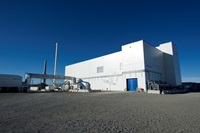Technical experts from around the country recently converged in Idaho Falls to aid DOE’s efforts to safely and effectively start up the Integrated Waste Treatment Unit (IWTU), intended to treat the approximately 900,000 gallons of remaining radioactive liquid tank waste at DOE’s Idaho Site.
Scientists and engineers from DOE-Idaho, DOE-Headquarters, the Idaho National Laboratory, Idaho Cleanup Project, the National Engineering Technology Laboratory, and Hazen Research met at a Fluidized Bed Workshop in mid-April to discuss the mechanical processes that take place within the IWTU’s Denitration Mineralization Reformer (DMR), a key reaction vessel in the facility.

The gathered experts discussed the conditions observed inside the DMR during three prior waste simulant runs. During these runs, which used a non-radioactive chemical mixture with similar properties as the actual liquid waste stored in three underground tanks, operators and engineers noticed the formation of a bark-like material inside the DMR vessel walls.
The workshop participants discussed what process operating conditions could be contributing to the bark-like formation inside the DMR vessel. DOE is working to meet an agreement with the state of Idaho to begin actual waste processing at IWTU by Sept. 30, 2016. The Department will only begin operations at the IWTU, however, when it is safe to do so.

